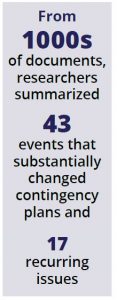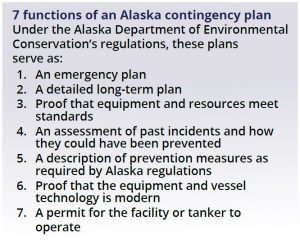
Thousands of pages of documents. Countless meetings and workgroups. Over thirty years of oil spill drills and exercises.
That’s what you’d previously have to dig through to truly understand the oil spill contingency plan for Prince William Sound’s tankers.
Not anymore. A new report has now distilled that history down into one report.
The Council partnered with experts at Nuka Research and attorney Breck Tostevin to comb through decades of letters, reports, and meeting notes. They were looking for details on how the plan, and the regulations that shaped the plan, developed.
What is the plan?
The Prince William Sound Tanker Oil Spill Prevention and Contingency Plan essentially describes how Alyeska and the tanker companies prevent oil from spilling, and how they will contain and clean up the oil if a spill happens.
State and federal laws and regulations determine what details are included in the plan. The industry writes the plans and government agencies decide whether the plan meets their requirements.
Documenting the changes over time
There have been numerous changes to the plan and its governing regulations over the years.
Changes are made on a regular basis through an extensive and complicated renewal process. A lot of work and thought goes into these updates. In a nutshell, every five years:
- the industry proposes changes,
- the government reviews the changes and solicits public comment,
- the Council and stakeholders review and submit comments,
- and the comments and changes are considered and worked out between the industry and the government.
The government approves the plan once it meets their requirements.
Details are written down in various documents. The researchers started with the first plan developed after the Exxon Valdez oil spill, documenting how the then-new state requirements resulted in many changes, and tracking subsequent changes through 2020.
Their work shows that many Alaskans, including industry, government agencies, and citizens worked hard to tailor the plan and regulations so that it works for our unique state.
“An Alaska contingency plan is not a generic plan on how to respond to spills,” note the researchers in the report.

How will this report help protect Prince William Sound?
Those who wrote, organized, reviewed, and approved the plans acquired an extensive knowledge of the contents of the plans. They knew why the plans and regulations were written a certain way because they were the ones who made the changes.
Years later, many have retired, but they left a trail of details in historical documents.
The report details how the plan has improved, describes contentious issues and how they were resolved, notes significant trends, and documents remaining issues. The report also documents changes to the regulations and how regulations have been interpreted at different times.
“This project helped us understand how regulatory philosophies, requirements, oversight, and enforcement have changed over the years,” said Linda Swiss, a Council staffer who was part of the team that developed the history.
Swiss has been managing contingency plan projects for over 12 years for the Council.
“We were in a unique position to do this project because we have one of the most extensive collections of historical documents that I know about,” Swiss added.
The researchers were able to find information on missing events not available anywhere else.
“It will be helpful for future planners and plan reviewers,” Swiss noted.
“It is hoped this history will be a useful tool in understanding past work and the rationale behind certain commitments, and perhaps more importantly to help prevent any backsliding or diminishment of oil spill prevention and response capabilities for Prince William Sound and its downstream communities,” Swiss said.
Read the report
Historical summary:
PWS Tanker Oil Spill Prevention & Contingency Plan, Summary 1995-2020
Compendium of event summaries:
PWS Tanker Oil Spill Prevention & Contingency Plan, Event Summaries 1995-2020
Graphic timeline:
Timeline of major events and changes to the PWS Tanker Oil Spill Prevention & Contingency Plan